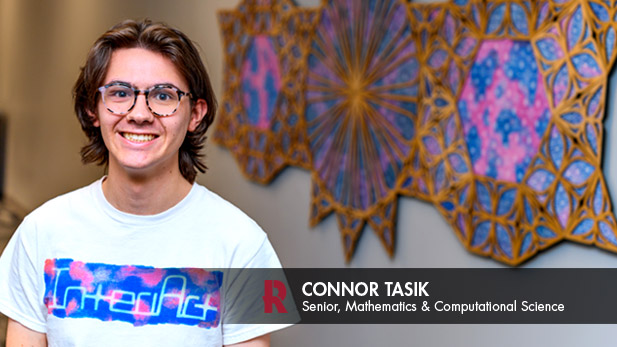Connor Tasik Optimizes Moench Hallway with Mathematical Art Project

Connor Tasik, a senior mathematics and computational science double major, combined art and mathematics research in a vibrant new art installation in Moench Hall.
Senior mathematics and computational science double major Connor Tasik gazed, wonderstruck, at the newly installed artwork in Moench Hall and sported a shirt to match. Combining mathematics, printmaking, and woodworking, Tasik devoted nearly fifty hours a week this summer to creating the visually stunning piece, and as the 2025-26 academic year begins, Tasik's handiwork brightens an expanse of wall in a student study area in Moench’s F-hallway, near the Department of Electrical and Computer Engineering.
"I'm really excited," Tasik, who is pursuing an art minor, said. "It's the biggest project I've ever attempted. I'm really proud of it."
The project is the culmination of research begun in fall 2023 by a group of students and Professor of Mathematics Al Holder, PhD. The group has explored the interior point method, which revolutionized the field of optimization by allowing scholars to solve increasingly large problems with millions of variables.
“Think of it like you’re on top of a square platform, and at the edges, there is a sharp drop, but in each of the corners, there is a million dollars,” Tasik analogized. “You’re spun in a random direction and have to start walking that way. As you get closer to the edge, you’re going to want to turn away from it and walk toward the closest corner.”
Tasik explained, "In linear programming, which is a subfield of optimization, we have a theorem that says this is going to converge into a corner, and the constraints determine the path it takes."
"You might see this used to solve a problem of how to determine which radio frequencies different cell towers can use so they don't interfere," Tasik continued.
Tasik expanded the research group's work by translating the interior point algorithm into a vivid, tangible display.
"I have directed dozens of undergraduate projects, but working with Connor on this artistic pursuit has been unique and special," said Holder. "The beauty and joy of most mathematical pursuits are clear only to those with rigorous training, but Connor's work extends a rich mathematical exposition into a delightful reality for all to enjoy."
In addition to the mathematical research, Tasik completed a Material Science of Art course (MDS 390) taught by Associate Professor of Art Soully Abas, MFA, and Assistant Professor of Physics, Optical Engineering, and NanoEngineering Nicole Pfiester, PhD, which introduced the process of cyanotypes. Cyanotypes are frequently used to create architectural blueprints, or, in Tasik's case, t-shirts to match their art. Tasik’s installation day outfit featured a cyanotype of the design, as well as a font created from the model's pathways.
"Connor's the kind of student you dream of having in the classroom," said Abas. "It's been inspiring to watch this piece come to life and witness Connor overcome challenges like scale, technical issues, and time restrictions."
Entitled, "InteriSpection," Tasik's piece layers laser-cut wood paths, the white central path lines of the interior point algorithm, and a blue, pink, and violet gradient to invoke a sense of order amidst chaos.
"I think it's really easy at Rose to get caught up in classes and not have (time to reflect) on how life-changing college is," Tasik said. "This summer, I've finally had some time to reflect on how much I've grown as a person at Rose, and that's where the idea of introspection came from."
Though introspection might be a new journey, math and art have always been entwined for Tasik. Their great uncle, a stone sculptor, taught them the basics of the craft, including sculpting mathematical shapes.
"It's easy to think math and art are really different, but there's an underlying beauty to both of them," said Tasik. "As you get into higher level mathematics, everything falls together in a really nice way. There's a lot to explore there that is almost inherently pleasing to the eye because there's a lot of structure to it and because of how much we crave structure."
Tasik plans to unveil more of that underlying beauty, working with Holder to expand the work for a senior thesis project. The goal is to project the 2D model onto a curved surface, such as a coffee mug. Tasik and Holder also hope to develop a complete font from the model, dubbing their pieces, "InteriArt."
Tasik has already adapted the model to other artistic mediums, including 3D printed sculptures, keychains, and stencils used for activities during the math department's annual Sonia Kovalevsky Day of Math outreach event.
After graduating from Rose-Hulman, Tasik intends to study applied mathematics and optimization in graduate school while continuing to develop art and math outreach events, aspirations that layer beautifully with the InteriSpection project.
"It's made me feel a bit more like I've got a place in the field," Tasik said.
Tasik also dreams of becoming a professor and teaching courses about math and art. They hope that their artwork inspires other Rose-Hulman students to explore the links between different disciplines.
"I think it's really easy to think how disjointed art and STEM fields are," said Tasik. "This is a testament to how, even though we are a STEM college, we can do artistic things."
Tasik will host a "Meet the Artist" event during the mathematics department's homecoming open house on Saturday, October 4, in the F-Wing hallway of Moench Hall. Tasik and Holder will be available to discuss the underlying mathematics and the artistic acumen necessary to create the piece.